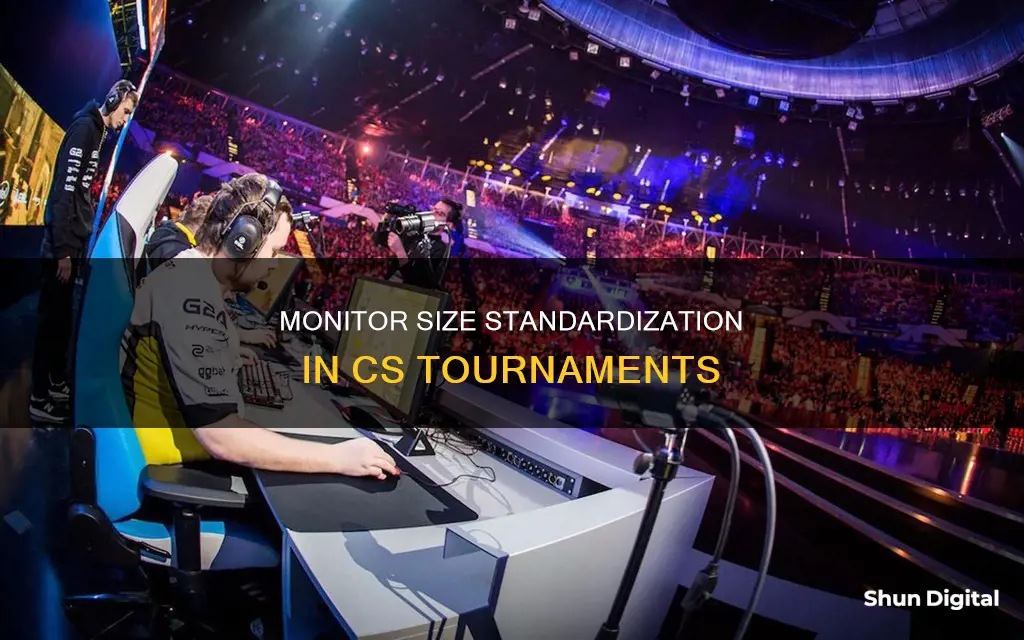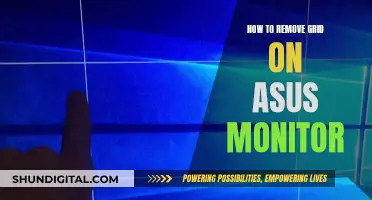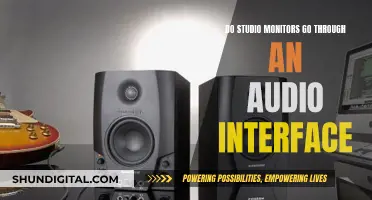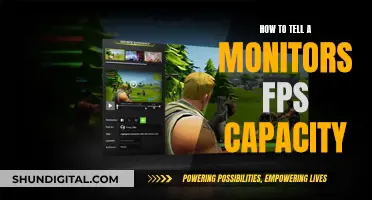
The size of monitors used in CS tournaments is a topic of interest for many gamers. While there is no definitive answer, as it may vary depending on the tournament and player preferences, most professionals opt for medium or small-sized monitors. The most popular screen size among pro players is 24, but 27 monitors are also commonly used. Smaller monitors can be advantageous for CS tournaments as they provide a higher frame rate, even if the PC specifications are not top-notch. Additionally, a larger screen size may require more powerful hardware to prevent lags, and the increased details may distract players.
| Characteristics | Values |
|---|---|
| Monitor size | 24-27" |
| Refresh rate | 144-360Hz |
| Resolution | 1920x1080 |
| Display panel | TN or IPS |
| Aspect ratio | 4:3 or 16:9 |
What You'll Learn

24-inch monitors are the most popular for CS tournaments
24-inch monitors are the most popular choice for CS tournaments. This is because a 24-inch monitor provides the perfect balance between screen real estate and performance. While larger monitors can provide a more immersive experience, they are often not ideal for competitive gaming, especially in the CS community.
CS is a game that heavily relies on quick reactions and split-second decisions. With a 24-inch monitor, players can maintain a comfortable viewing distance without having to move their eyes too far across the screen. This is crucial for tracking enemies and can make the difference between winning and losing a round. Additionally, larger monitors often require more powerful hardware to run games smoothly at higher resolutions, which can be a disadvantage for some players.
The standard refresh rate for competitive CS gaming is at least 144Hz, with many tournaments now adopting 240Hz monitors. A higher refresh rate means a smoother image and less screen tearing, giving players an advantage in fast-paced situations. While 60Hz monitors are sufficient for casual play, competitive players require higher refresh rates to keep up with their opponents.
When it comes to resolution, many professional players opt for 1080p on their 24-inch monitors. This lower resolution allows their computers to push higher frame rates, which is crucial for competitive play. While some players may prefer higher resolutions like 1440p, it is not uncommon to see them lower the resolution to gain a competitive edge.
The Zowie XL2546 and its successor, the XL2546K, are popular choices among CS players. These monitors offer a 240Hz refresh rate, 1ms response time, and features tailored for competitive gaming, such as the Black eQualizer function, which improves visibility in dark areas of the map.
In conclusion, 24-inch monitors strike a balance between performance and screen size, making them the preferred choice for CS tournaments. With their high refresh rates, quick response times, and tailored features, these monitors give players the tools they need to perform at their best during competitive play.
Best Monitor Size for Editing: How Big is Too Big?
You may want to see also

27-inch monitors are also used, but less common
While 24-inch and 25-inch monitors are the most common sizes used in CS tournaments, 27-inch monitors are also used, but less frequently.
The size of the monitor is important for competitive gamers, as a larger screen can provide a better picture and quality. However, in shooters like CS, a big screen can be a disadvantage. Firstly, a larger screen requires more powerful hardware, which can cause lag. Secondly, a bigger picture has a lot of tiny details, and it can be easy to miss important information. Finally, lowering the graphics settings on a large monitor can negatively impact the gaming experience.
For these reasons, professional players usually opt for medium or small-sized monitors. While 24-inch monitors are the most popular, 27-inch monitors are also used and can be a good choice for gamers who also want to use their monitors for other activities, like watching films or video editing.
Ultimately, the optimal size of a monitor depends on individual preferences and the type of games played.
Choosing the Right-Sized Drawing Monitor for Your Needs
You may want to see also

A high refresh rate is important for a gaming monitor
The standard monitor size for CS:GO tournaments is 24 or 25 inches, with a 240Hz refresh rate. However, some tournaments use 144Hz monitors.
For example, a 60Hz monitor will refresh the image 60 times per second, while a 144Hz monitor will refresh it 144 times per second. This means that with a 144Hz monitor, you will see more than double the amount of image information per second than with a 60Hz monitor. This provides a very noticeable difference in the smoothness of the action on your screen while gaming.
High refresh rates can offer some key benefits for gamers. Firstly, you will have an overall better gaming experience thanks to smoother visuals and gameplay. High refresh rates also help improve your skills in-game by allowing you to track the action more quickly. This is especially important for fast-paced games such as Counter-Strike, where being able to track a player's movements precisely can be the difference between a headshot or a miss.
In addition, high refresh rates can help reduce input lag, which is the delay between making an input and the game recognizing it. While the difference is tiny, in the order of milliseconds, it can still make a difference in competitive scenarios. For professionals and serious players, every tiny advantage matters.
However, it's important to note that a high refresh rate monitor may not be worth the extra cost if you're a casual gamer or don't play video games at all. There are few applications outside of gaming where higher frame rates will make a noticeable difference. In such cases, it's better to invest in a larger, higher-resolution monitor or one with better image quality.
Biggest Battle: Nintendo vs. Cab Monitor Size Wars
You may want to see also

Monitor size depends on the distance between the player and the screen
Monitor size is a personal preference and depends on the distance between the player and the screen. The optimal viewing distance for a monitor is generally considered to be a distance equal to the monitor's diagonal measurement. So, for a 24-inch monitor, the optimal viewing distance would be around 24 inches or 60 cm. If you sit closer to the monitor, a smaller screen size is preferable, and if you sit further away, a larger screen size is better.
For competitive Counter-Strike players, a medium or small-sized monitor is usually preferred. The most popular screen sizes among professional players are 24 inches and 27 inches. A smaller monitor can provide an advantage in shooters like CS:GO because it allows for faster reactions and easier focus. With a large screen, you might miss something important because there is too much to look at. Additionally, a large screen requires more powerful hardware to run games smoothly, and it can be challenging to achieve high frame rates with a low-end PC.
Some players also prefer a smaller monitor because it allows them to sit closer to the screen, which can improve their reaction time and peripheral vision. A larger monitor, on the other hand, provides a more immersive experience and can be more comfortable for long gaming sessions. It's worth noting that the aspect ratio and resolution also play a significant role in the gaming experience, and some players may prefer different monitor setups based on their personal preferences and the type of game they are playing.
When choosing a monitor size, it's important to consider the distance between the player and the screen, as well as the player's preferences, the type of games they play, and the hardware specifications of their PC.
Monitoring CPU Usage: Surpass Hosting for Better Server Performance
You may want to see also

A bigger screen is not always better for gaming
When it comes to CS tournaments, the standard monitor size is 24 or 25 inches, with a 240Hz refresh rate. While a bigger screen may offer a more immersive experience, it's not always the best option for gaming, especially in competitive play.
Firstly, larger screens often have slower refresh rates, which can cause noticeable lag or latency. This is a critical factor in fast-paced games, where a split second can mean the difference between winning and losing. To eliminate any potential disadvantage, most pro gamers opt for smaller screens with higher refresh rates, typically 144Hz or above.
Secondly, smaller screens bring the entire screen closer together, reducing the need for extensive eye movements to track various elements like radar, cooldowns, and other game information. This allows players to maintain better awareness of their surroundings and make more precise inputs, which can be the difference between securing a kill or being outplayed.
Additionally, smaller screens often have faster response times, ensuring that inputs are registered instantly. This is crucial in competitive gaming, where every frame and millisecond counts. The faster response times of smaller screens provide an edge that can mean the difference between victory and defeat.
While a bigger screen can enhance the visual experience, it may not always provide a performance advantage. In competitive gaming, where every advantage matters, a smaller screen with a higher refresh rate, lower response times, and reduced input lag can be the key to success. Therefore, it's essential to consider the specific requirements of the game and the player's priorities when choosing a screen size.
Verizon's Data Usage Monitoring: What You Need to Know
You may want to see also
Frequently asked questions
The most popular monitor size for CS tournaments is 24 inches, with some tournaments also using 25-inch monitors.
A 24-inch monitor is the preferred choice for professional gamers as it provides a high refresh rate and fast response time, which is crucial for competitive gaming. Additionally, a smaller screen size allows for higher frame rates, even on lower-spec computers.
Yes, some gamers may prefer a 27-inch monitor for casual gaming or if they also intend to use it for other activities such as video editing or watching films. However, a larger screen size may require more powerful hardware to maintain optimal performance and can be more difficult to see from a typical viewing distance.







